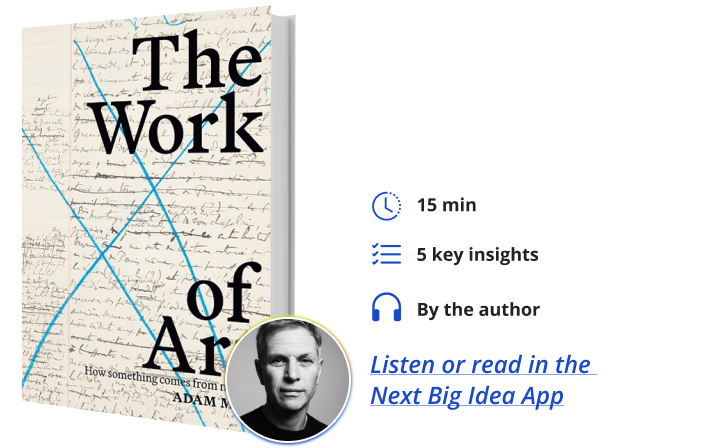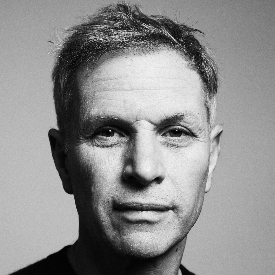Adam Moss was the editor of New York magazine, The New York Times Magazine, and 7 Days. He also oversaw the creation of five digital magazines: Vulture, The Cut, Daily Intelligencer, Grub Street, and The Strategist. While editor of New York magazine, the publication won forty-one National Magazine Awards, including Magazine of the Year. Moss was also an assistant managing editor of The New York Times and managing editor of Esquire. He entered the Magazine Editor’s Hall of Fame in 2019.
Below, Adam shares five key insights from his new book, The Work of Art: How Something Comes from Nothing. Listen to the audio version—read by Adam himself—in the Next Big Idea App.

1. Hack your way through the wreckage.
The work of artists requires perseverance through failure. Every artist fails over and over again. I should have known this, but I was always surprised, perhaps because I romanticize artists so much. It is the spine of every narrative in the book: the most successful artists simply persist. They do not give up when almost everybody else probably would.
Getting Married Today, one of the greatest theater songs of all time, written by Steven Sondheim, was a much-belabored song. Sondheim ripped it up almost entirely before understanding the rhythm required to make it work. The writer Michael Cunningham threw away version after version of The Hours, making radical changes until he arrived at his Pulitzer Prize-winning idea. The writer George Saunders took over two decades to write his Man Booker Prize-winning novel, Lincoln in the Bardo, trying it first as a short story and a play before finally nailing the voice he’d need to write the novel.
Author James Baldwin said, “Talent is insignificant…Beyond talent lie all the usual words: discipline, love, luck, but most of all, endurance.” Being able to endure through failure separates the great from the good.
2. Become not you.
Creating works happens in three stages: imagining, judging, and shaping. The judging doesn’t get near enough love. Making something means being able to cast a critical eye on your own work. You need to see with dispassionate scrutiny (without annihilating yourself in the process) what your imagination has spewed before being able to act on it. It is the crucial middle stage, the ability to edit, see, and react to your first impulsive expression.
“Making something means being able to cast a critical eye on your own work.”
Editing, artist Twyla Tharp said to me, asks, “How much objectivity do you have? Really? How much can you disassociate from your own bias? How much can you disassociate yourself from the wish fulfillment component that is involved in work?” You’ve got to become not you.
3. Your subconscious does a lot of the work, but only if you’ve set yourself up for it.
People often get the best ideas when they’re not thinking about them—artists included. But for this to happen, the brain has a few requirements. Setting up the brain so ideas can emerge from the subconscious happens in two parts.
One part is lifelong. It is the training. You need skills to make anything, and they need to be ingrained. People who try to encourage creativity don’t dwell much on skills. Maybe because to say so seems undemocratic, but skills for artists are like an athlete’s body. Memory matters. Craft matters. Studying the masters matters. Experience matters. There are no shortcuts.
The second part is temporal planning. Great artists spend most of their time refining their ideas and setting up the proper structures to express them—not so much time making them. The great work of Kara Walker’s sublime Giant Mammy sculpture from her large-scale public project called A Subtlety was commissioned from the PowerPoint she devised to figure out what to do in an abandoned sugar factory. The PowerPoint bewildered her funders. What does a PowerPoint have to do with art? But she couldn’t proceed without it. The writer, Sheila Heti, created an entire cosmology to teach her how to write her legendary book, How Should a Person Be? Nobody saw it, but it was the necessary predicate to her novel.
Your brain needs the right ask in order to deliver an answer. If the training is in your bones and you’ve done the preparation for something you’re trying to make, often you can just step away and let your unconscious have at it. It’s a miracle, but a miracle that takes a lot of work.
4. The brain is an easy and necessary thing to trick.
The brain wants to sabotage you in all sorts of ways. As a creator, you’re aiming for productive disassociation to enter the inarticulable world of the subconscious, capture what to use, and then drag it back to a conscious place where you can act on it. But the brain is built to stop you from this.
“Luckily, great artists have devised superstitions and games and hacks to fool the brain.”
The brain has done such a good job protecting you from painful things. It has cut grooves that are helpful in all sorts of ways, but those practical pathways can inhibit creative thinking. Luckily, great artists have devised superstitions and games and hacks to fool the brain, making deals with themselves and also especially giving themselves explicit permission to fail. The playwright Tony Kushner writes drafts in longhand so that “they don’t count.” The painter Amy Sillman has a deliberate stage while making paintings in which she decides beforehand that she will paint over what she does—this gives herself permission to just let it rip. Deliberate acts of self-delusion work.
5. Let go of the end, relish the middle.
I was constantly surprised to realize how little the result of an artist’s labors was self-described as the book, painting, or song. Instead, artists talked to me about matters regarding the completion of these works that brought them acclaim. All they could express was emotions, like relief or exhaustion. Perhaps that’s because the thing itself was not actually the point. What the artist was consumed by was the journey of getting to the point of completion.
Art is hard, which is exactly what is so satisfying about it. Victories are fleeting. The struggle is every day. It’s the work, the artists kept saying. Eventually, I believed them.
To listen to the audio version read by author Adam Moss, download the Next Big Idea App today:
































